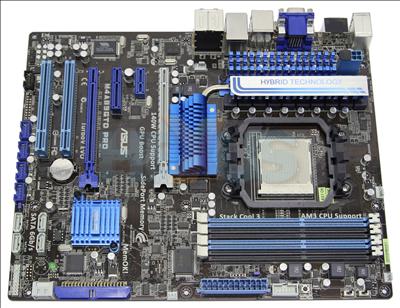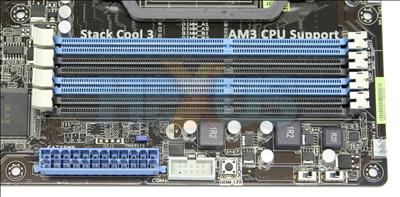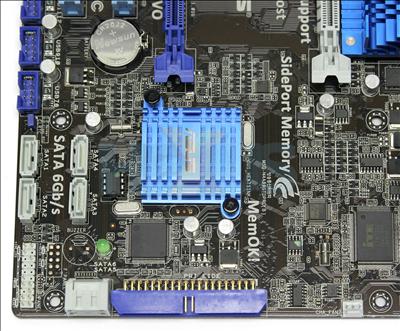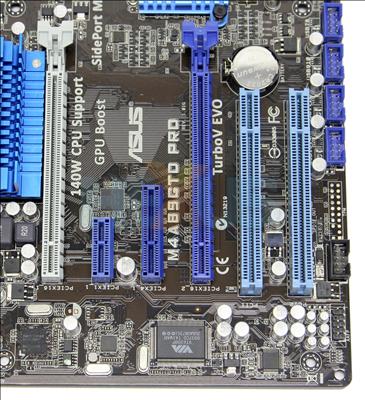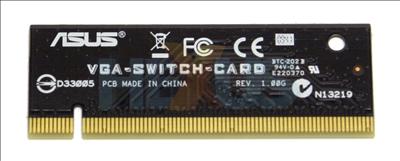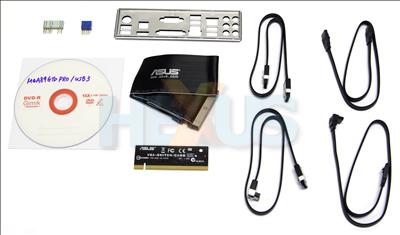ASUS M4A89GTD PRO/USB3: layout and features
ASUS's M4A89GTD motherboard is currently available in two variants; PRO priced at around £115 and PRO/USB3 at approximately £130. We're testing the latter, and as the name suggests, it comes equipped with an NEC controller that enables the two USB 3.0 ports on the rear I/O panel. A further 12 USB 2.0 ports are present (eight on-board, four back panel), whilst the standard PRO model features 14 USB 2.0 ports (eight on-board, six back panel).
In keeping with most of ASUS' Xtreme Design range, the M4A89GTD PRO/USB3 retains a black ATX PCB with blue highlights. The board looks smart enough, and a tidy layout ensures there's plenty of room to manoeuvre. With AMD yet to combine its northbridge and southbridge components, however, the inevitable micro-ATX offerings are likely to be cluttered.
Aimed at the wallet-conscious enthusiast, the board supports all AM3 CPUs featuring a TDP of up to 140W and makes use of high-quality capacitors and an 8+2 phase power design. A 128MB DDR3 1,333MHz SidePort memory module is present, boosting performance of the Radeon HD 4290 IGP.
Four dual-channel DDR3 memory slots are available, supporting up to 16GB of RAM at speeds of up to 1,866MHz.
In the corner nearest the southbridge, you'll find the board's six SATA 6Gbps ports - four stand upright whilst two are angled at the board's edge. Powered by the SB850 southbridge, the third-generation SATA interfaces support RAID 0, 1, 5 and 10.
A JMicron JMB361 controller powers the angled IDE port, as well as a single 3Gbps eSATA port on the board's rear I/O panel.
ASUS's selection of expansion slots is good, consisting of two of the PCIe x16 variety, one PCIe x4, a PCIe x1 and two standard PCI slots.
The PCIe x16 slots will run at x8 apiece in a dual-GPU CrossFire configuration, but users running just a single discrete GPU should be aware that the bundled VGA Switch Card will need to be inserted into the grey slot in order to divert all 16 lanes to the primary blue PCIe x16 slot.
The M4A89GTD PRO/USB3's rear I/O panel is about as good as it gets. VGA, DVI and HDMI outputs are available from the IGP, Optical S/PDIF and eight-channel HD audio ports provide a choice of sound output, and storage options are ample with two USB 3.0 ports, four USB 2.0 ports, 3Gbps eSATA, FireWire 400 and Gigabit Ethernet powered by a Realtek 8111E controller. A secondary FireWire port, provided by the VIA 6308P controller, is available on the board itself.
ASUS was kind enough to provide us a sample of the board, but without final retail packaging. We understand the retail product won't differ in terms of bundled accessories - buyers can expect to find only the very basics, including a Ultra DMA 133/100 cable, two Serial ATA 3Gbps cables, two Serial ATA 6Gbps, a VGA switch card, user manual and both ASUS' Q-Shield backplate cover and Q-Connector.
Aside from all the standard 890GX chipset features, ASUS's implementation brings with it a number of proprietary tools designed to suit the enthusiast. Among these is Core Unlocker - allowing users to enable hidden/disabled cores on certain AMD CPUs. Flip the switch on the board itself, or toggle the BIOS option, and Core Unlocker will scan your processor and enable any working cores or caches that were previously hidden.
Turbo Key II, another hardware-based tuning tool, will automatically overclock your CPU at the flick of a switch, and ASUS MemOK! is present to diagnose and fix any memory compatibility issues.
As you'd expect, ASUS's array of hardware tools are accompanied by a feature-packed software suite. The highlights include TurboV for overclocking, EPU for power saving and FanXpert for controlling fan speeds.
Warranty
As with all its boards, ASUS provides a three-year return-to-base-warranty from the date of purchase on the customer's receipt. This is transferable between owners as long as the original receipt is retained.
The warranty is dealt with through the initial retailer, and assuming that you have the receipt, an RMA will be raised at the place of purchase and customers will receive a replacement board back within five working days, states ASUS.






